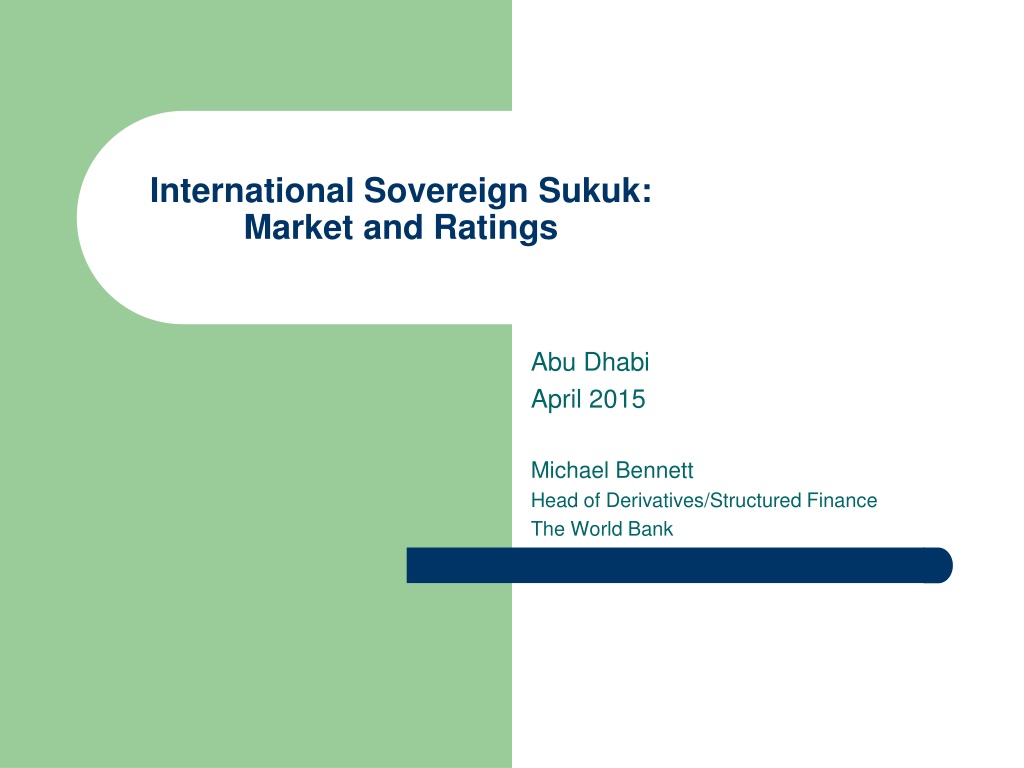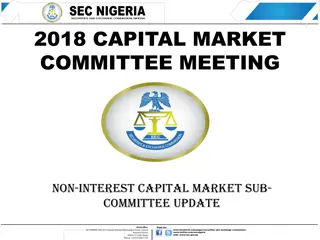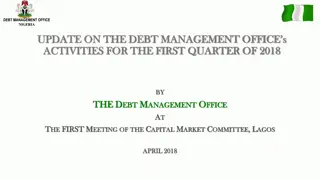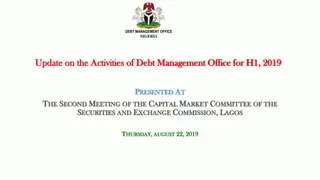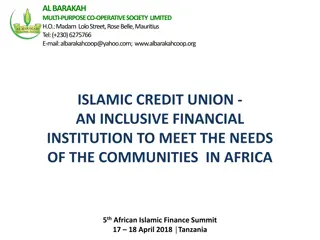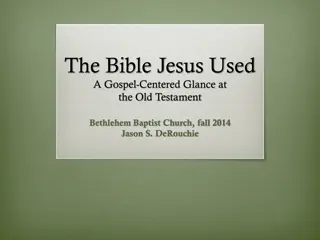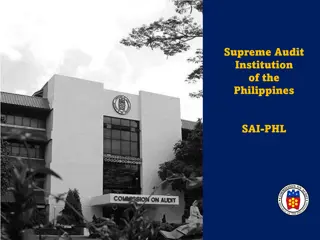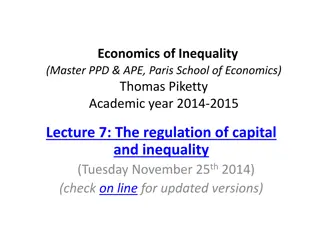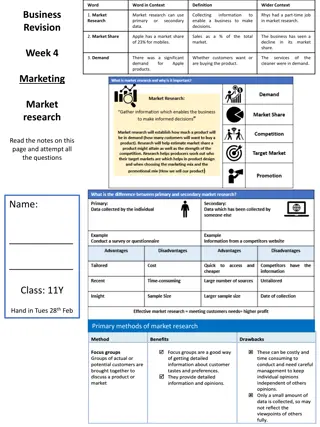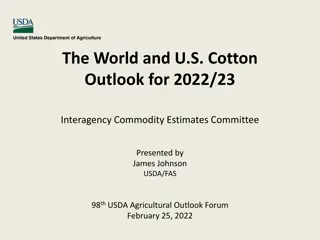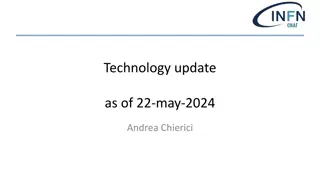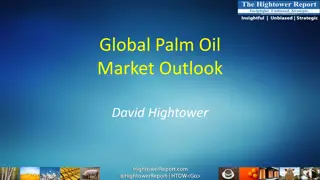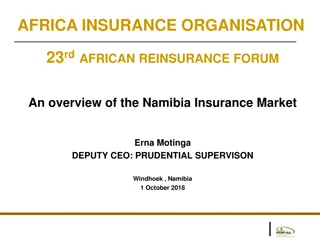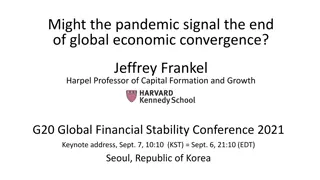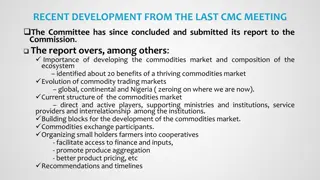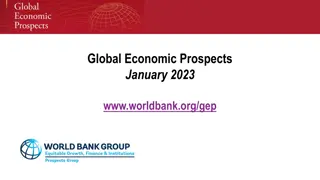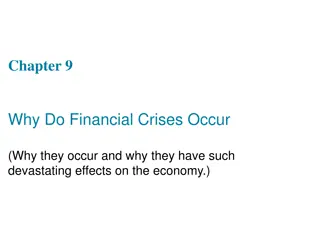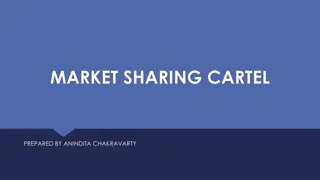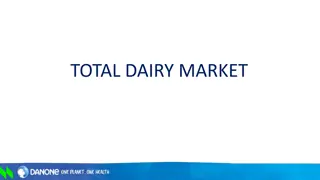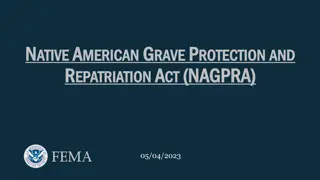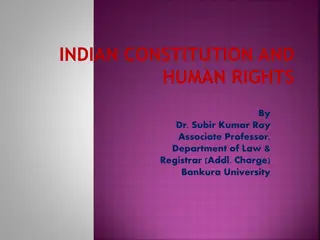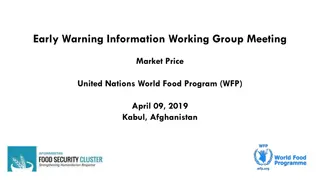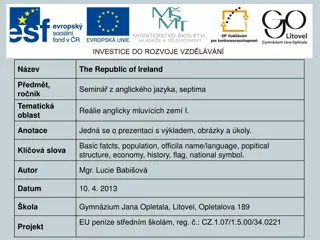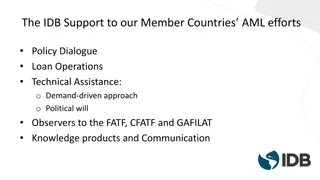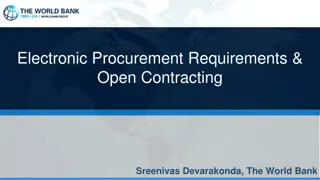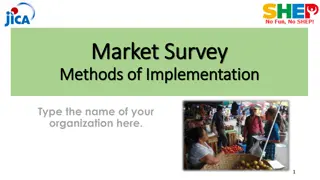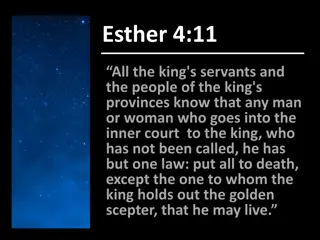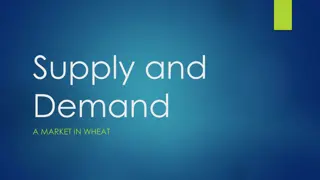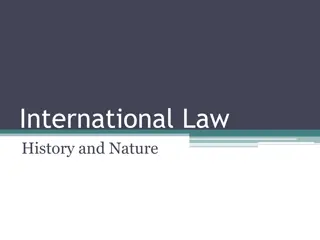Global Sukuk Market Trends and Sovereign Issuances Overview
Explore the latest trends in the global Sukuk market, including issuance volumes, international vs. domestic distributions, country-wise issuances, sectoral allocations, and the emergence of sovereign Sukuk markets. Discover how various financial centers compete for dominance, and how sovereigns, supra-nationals, and sub-sovereigns are accessing the international Sukuk market. Gain insights into the growth and diversification of Sukuk instruments across different regions and sectors.
Download Presentation

Please find below an Image/Link to download the presentation.
The content on the website is provided AS IS for your information and personal use only. It may not be sold, licensed, or shared on other websites without obtaining consent from the author. Download presentation by click this link. If you encounter any issues during the download, it is possible that the publisher has removed the file from their server.
E N D
Presentation Transcript
International Sovereign Sukuk: Market and Ratings Abu Dhabi April 2015 Michael Bennett Head of Derivatives/Structured Finance The World Bank
Sukuk Global Issuance Volume Global Sukuk Issuance in USD Billions US$131 bln 140 120 100 80 60 40 20 0 2009 2010 2011 2012 2013 2014
Sukuk International vs Domestic Issuance International 19% Domestic 81%
Sukuk Global Issuance (by country) Pakistan 1.4% Others (Kuwait, HK. Sudan, Turkey, etc) 1.4% Bahrain 2.5% Indonesia 3.2% Saudi Arabia 3.5% UAE 5.1% Qatar 11.6% Malaysia 71.2% Aggregate domestic and international issuance
Sukuk Global Issuance (by Sector) Transportation Construction Real Estate Government Financial Aggregate domestic and international issuance
Sukuk International Issuance Only Corporates 31% Government 33% Financials 36%
Sukuk Financial Center Doha, Dubai, Hong Kong, Kuala Lumpur, London, Riyadh and Singapore are all vying to be the principal financial center for sukuk Conventional financial centers London, Hong Kong and Singapore offer well developed capital markets infrastructure Islamic world financial centers Doha, Dubai, Kuala Lumpur, Riyadh offer access to most Islamic investors Regional differences in Shariah compliance may keep the market fragmented
International Sovereign Sukuk Several countries have developed active domestic sovereign sukuk markets Malaysia, Sudan Driven by domestic demand Increasingly, sovereigns are accessing the International sovereign sukuk market First issue by Bahrain (Central Bank) in 2001 2nd half of 2014: debut issues from UK, Luxembourg, Hong Kong and South Africa In addition, supra-nationals (IsDB, IFC, IFFIm) and some sub- sovereigns (DEWA) have accessed the market.
International Sovereign MultipleSukuk Issues Issuer No of Issues 8 6 4 4 3 3 2 2 Agg. Volume Largest Issue $750m $1 bln $1.25 bln $1.5 bln $2 bln $1.5 bln $500m $1 bln Bahrain Dubai Malaysia Indonesia Qatar Turkey Ras al Khaimah Pakistan $2.2 bln $5 bln $3.85 bln $4.15 bln $4.7 bln $3.75 bln $900m US$1.6 bln
International Sovereign Sukuk Issuer Quality International sovereign sukuk have been issued by issuers across the ratings spectrum Issuer S&P or Fitch Rating AA A- BBB- BB+ B- Qatar Malaysia Turkey Indonesia Pakistan
International Sovereign Sukuk Credit Enhancement Sukuk can be guaranteed by third parties (in similar manner as bonds and loans) Various potential guarantors governments (USAID, JBIC) and multilateral agencies (World Bank, MIGA, IsDB) could be considered
International Sukuk Investor Base Similar type of institutional investors as international sovereign bonds commercial banks, insurance, central banks, asset managers Concentrated in the Middle East and Asia: Issue Date Size Middle East/Asia Placement % 87% 79% July 2011 Oct 2013 US$1.2 billion US$ 500 million Malaysia Emirate of Ras Al Khaimah (United Arab Emirates) Qatar Bahrain July 2012 Nov 2011 US$ 2 billion US$ 750 million 76% 74% Sept 2013 US$ 1.5 billion 64% Indonesia Jan 2013 US$ 750 million 59% Emirate of Dubai (United Arab Emirates)
International Sukuk Investor Base For same issuer, much larger percentage of sukuk is placed in Middle East and Asia than conventional bonds: Issuer Issues % Placed in Middle East/Asia Sept 2013 US$1.5 billion sukuk July 2013 US$1 billion notes 64% 25% Indonesia Jan 2013 US$750 million sukuk Jan 2013 US$500 million notes 59% 16% Dubai Sept 2012 US$1.5 billion sukuk Jan 2012 US$1.5 billion notes 70% 0% Turkey (outside Turkey)
International Sukuk Investor Base Much of the demand for international sukuk comes from Islamic banks On the other hand, many large investment funds do not purchase sukuk Benchmark to indices that do not include sukuk Issuer Issues % Purchased by Banks 38% 6% 50% 37% 68% 40% 43% 34% % Purchased by Funds 51% 71% 36% 55% 24% 33% 22% 41% Sept 2013 US$1.5 billion sukuk July 2013 US$1 billion notes Oct 2013 US$1.25 billion sukuk Jan 2012 US$1.5 billion notes July 2013 US$2 billion sukuk Nov 2011 US$2 billion notes Nov 2011 US$750 million sukuk July 2013 US$1.5 billion notes Indonesia Turkey Qatar Bahrain
International Sovereign Sukuk - Structure Coupon Structure Fixed rate predominates Floating rate is possible Shariah Principle Almost all international sovereign sukuk have been based on IJARA Malaysia US$1.2 billion issue in 2011 based on a mix of WAKALA/IJARA AND MUDARABAH
International Sovereign Sukuk - Structure Most common assets used for sovereign ijara sukuk are land and government buildings: Issuer Structure Assets Ijara Airport terminals, cargo village, expo center complex Dubai Ijara Land in Doha and for Hamad Medical facility Qatar Ijara Land and various government facilities Indonesia Ijara Land, including land comprising the airport Bahrain Ijara Lahore-Islamabad Motorway Pakistan
International Sovereign Sukuk - Structure Many sovereigns cannot or are reluctant to sell government assets to a special purpose vehicle (SPV) So traditional ijara sukuk structure in which an asset is sold to a SPV and leased back by the government are inappropriate Variation of ijara sukuk used by those governments is head lease/ sub-lease structure
International Sovereign Sukuk Listing / Governing Law Although sukuk primarily trade OTC, many investors prefer to purchase listed instruments Governing Law: Governing law of sukuk itself is usually English law Governing law of underlying documents (eg, lease) may be domestic law of the country In addition, Shariah compliance is required Many different opinions needed: English law opinion Domestic law opinion Shariah opinion
International Sovereign Sukuk Listing / Governing Law Issuer Issue Date Size Governing Law English Listing July 2011 US$1.2 billion Bursa Malaysia Hong Kong Stock Exchange Labuan Financial Exchange London Stock Exchange London Stock Exchange Irish Stock Exchange Singapore Stock Exchange Dubai Financial Markets Malaysia Nov 2011 July 2012 Sept 2012 Nov 2012 Jan 2013 US$750 million US$2 billion US$1.5 billion US$1 billion US$ 750 million English English English English English Bahrain Qatar Turkey Indonesia Emirate of Dubai (United Arab Emirates) Indonesia Turkey Emirate of Ras Al Khaimah (United Arab Emirates) Sept 2013 Oct 2013 Oct 2013 US$1.5 billion US$1.25 billion US$500 million English English English Singapore Stock Exchange Irish Stock Exchange NASDAQ Dubai Dubai Financial Markets
Strategic Objectives of International Sovereign Sukuk Issuance Fund foreign currency requirements Diversify the sovereign s investor base + meet government funding needs beyond the domestic market capacity Access a market that accommodates large sized transactions Raise market profile and visibility Open the international sukuk market for other issuers from the country Obtain cost effective foreign currency funding 20
Investor Diversification Developing a well diversified investor base should be an objective of ant public debt management strategy Only way for sovereign to access Islamic capital is through sukuk Increase profile among investors in the major sukuk markets GCC, Malaysia
Investor Diversification Islamic Capital Bank Assets The global pool of Islamic capital is still relatively small: If all assets of Islamic banks globally were put in a single bank it would only rank 16th among global banks All Islamic fund assets are less than size of largest US bond fund BUT, Islamic capital is growing can add a diversifying element to investor base that will grow over time. ICBC (China) HSBC (UK) Mitsubishi UFJ (Japan) Deutsche Bank (Germany) Credit Agricole (France) BNP Paribas (France) JP Morgan Chase (USA) Barclays (UK) China Construction Bank (China) Bank of America (USA) US$2.79 trillion US$2.69 trillion US$2.66 trillion US$2.65 trillion US$2.64 trillion US$2.51 trillion US$2.36 trillion US$2.35 trillion US$2.21 trillion US$2.20 trillion 1 2 3 4 5 6 7 8 9 10 Agricultural Bank of China (China) US$2.10 trillion 11 Royal Bank of Scotland (UK) US$2.07 trillion 12 Bank of China (China) US$2.02 trillion 13 Mizuho (Japan) US$1.96 trillion 14 Citigroup (USA) US$1.86 trillion 15 ALL ISLAMIC BANKS GLOBALLY US$1.80 trillion 16
Sukuk Market Size of Transactions International sovereign sukuk market can accommodate very large sized transactions Average size of sovereign sukuk is just over US$1 billion Demand for international sovereign sukuk far exceeds supply Most sovereign sukuk issues have been very over-subscribed
International Sovereign Sukuk - Oversubscription Issuer Issue Date Final Size Order Book Size Over- Subscription Nov 2011 US$750 million US$1.7 billion 2.3 times Bahrain Sept 2012 US$1.5 billion US$7.1 billion 4.7 times Turkey Jan 2013 US$750 million US$11 billion 14.6 times Emirate of Dubai (United Arab Emirates) Sept 2013 US$1.5 billion US$5.7 billion 3.8 times Indonesia Oct 2013 US$500 million US$5.5 billion 11 times Emirate of Ras al Khaimah (United Arab Emirates) Oct 2013 US$1.25 billion US$7.7 billion 6.2 times Turkey Nov 2014 US$1 billion US$2.3 billion 2.3 times Pakistan
Sovereign Sukuk Raise Profile International sovereign sukuk are placed largely in the Middle East (GCC) and Asia (Malaysia) Roadshows and other marketing in these regions can help create positive attention for a country Issuance of sukuk could lead to stronger trade ties going forward
Sovereign Sukuk Open the Market for Other Issuers Issuing a sovereign sukuk can create interest in a country among international investors Sovereign sukuk prospectus includes significant detail on the country s economy Sovereign sukuk is generally followed by sukuk from: State owned enterprises or parastatals Banks and companies with significant state ownership Corporates
Sovereign Sukuk Open the Market for Other Issuers Country Year of 1stInt l Sovereign Sukuk 2002 Industry Date of 1st Sukuk 2004 2006 2007 2009 2013 2005 2006 2006 2007 2007 2007 2011 2012 2012 2013 Selected Other Int l Sukuk Issuers Sarawak Corporation Khazanah Nasional Maybank Petronas Sime Darby Emirates Airlines DP World Nakheel Dubai Islamic Bank Dana Gas Tamweel Emaar Majid Al Futtaim Group Emirates Islamic Bank Dubai Electricity and Water Authority GEMS Education Malaysia Gov t Agency Gov t Fund Financial Energy Conglomerate Transportation Property Property Financial Energy Property Property Property/Retail Financial Utility 2004 Emirate of Dubai (United Arab Emirates) Education Property 2013 2006 2003 Qatar Real Estate Investment Company Qatar Islamic Bank Almana Group Qatar Int l Islamic Bank Ooredoo Bank Asya Turkiye Finans Albaraka Turk Qatar Financial Trading Financial Telecom Financial Financial Financial 2010 2011 2012 2013 2013 2013 2013 2012 Turkey
Sovereign Sukuk Cost Efficiency International sovereign sukuk generally provide funding at a level similar to international sovereign bonds Clearly more expensive way to obtain foreign currency than concessional financing from multilateral or agencies When the market began, sukuk financing was slightly more expensive than bonds Premium due to lack of familiarity with the product and uncertain liquidity/price performance Since 2012, international sovereign sukuk generally price flat or slightly through international bonds
Sovereign Sukuk Selection of Assets The assets used for the structure should meet the following criteria: Be unencumbered by any liens or pledges Not be used for any non-Shariah compliant purposes Be owned by the obligor Have instrinsic value equivalent to the amount of funds being raised
Sukuk Rating Asset Backed (Secured) Structures vs Asset Based (Unsecured) Structures Rating of asset backed structures will depend in part on value of the underlying assets Rating of asset based structures depends on the credit quality of the underlying obligor 95% of sukuk are asset based
Sovereign Sukuk Types of Rating Factors Variable GDP Growth GNI per capita Reserves/Imports+ short term debt External debt/Exports + remittances GDP Volatility Rule of Law Inflation Explanation 3 year moving average of GDP growth Gross national income, divided by working population Total reserves divided by sum of imports and short term debt External debt divided by sum of exports and remittances 5-year standard deviation of GDP growth Qualitative judgment on respect for rule of law Annual consumer price
Ratings of Islamic Banks Overall similar to rating methodology for conventional banks Differences from rating perspective: More concern with liquidity management High concentration of real estate risk Need for robust Shariah compliance procedures Risk of losing customer confidence if problem with 43Shariah compliance Treatment of Profit Sharing Accounts
Islamic Banks Profit Sharing Accounts Rating agencies look at how banks classify their profit sharing accounts: In practice, Islamic banks generally guarantee full repayment so these accounts are implicitly deposits Rating agencies look at whether bank is treating profit sharing accounts eg, for risk weighted assets - as true risk shares or as deposits
Do Ratings Consider Shariah Compliance? Could a party escape paying on the basis of lack of Shariah compliance? Investment Dar vs Blom Bank Case in UK Claims by Islamic instiutions Introuof lack of capacity since transaction was not truly Shariah compliant Introduces element of uncertainty on legal enforceability More relevant for Islamic institutions than sovereigns
Disclaimers The findings, interpretations and conclusions expressed herein are those of the presenter and do not necessarily reflect the views of the World Bank or its affiliated organizations. This presentation has been prepared for informational purposes only, and the presenter makes no representations or warranties of any kind as to the accuracy or completeness of any of the information contained herein.
